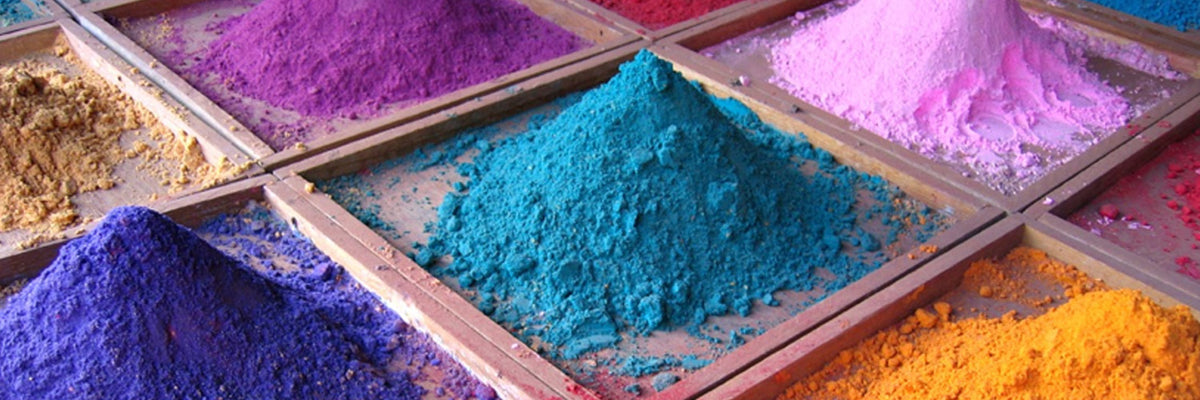- Regular Price
- $ 19.99
- Sale Price
- $ 19.99
- Regular Price
- $ 19.99
- Unit Price
- per

An elementary part of textiles are dyes, since people always need to incorporate a touch of color into objects and it is normal, because they are intended to be innovative, creative or attractive.
Always to add a dye to a fabric or thread it is necessary to prepare it with certain finishes or cleaning so that the color is impregnated into them.
Now, there are different types of dyeing, whether natural, artificial or synthetic. Later we will tell you how each of these works.
Well, natural dyeing is acquired from different natural resources such as animals, plants, spices, roots and other things. For example, cochineal or red fruits dye red or pink, brazilwood generates purple, indigo creates blue, and saffron or turmeric produces yellow.
Of course, there are others around the world and they are extracted in a different way, but they are an excellent option if you are looking for a sustainable way, as they reduce waste and have outstanding pigmentation.

Illustration 1: Natural inks.
Artificial dyes are a mixture of chemicals with natural components such as plants or rubies so that when mixed, other fibers, threads or fabrics can be dyed. They can generally be found under the name horse, butterfly or similar dye in supermarkets or hardware stores.
They are very easy to use, all you need is to boil water in a pot, put the dye inside it and then put the skein, fabric or garment that you are going to dye. Then you seal it with salt or vinegar and let it dry.

Illustration 2: Artificial dyes.
Synthetics are only chemical-based, they are effective, since the color is perfectly impregnated, you can leave it without using it for a long time and use it several times because it takes time to spoil.
Most of them are used mainly in factories and industries. However, they are among the most polluting and many of the residues remain in the water.

Illustration 3: Synthetic dyes.
Just as there are different dyes, there are also different dyeing techniques. Below we explain each of them.
Pre-dyed is when color is added to the fiber or threads after being treated and cleaned. In this process the color looks uniform and when it is woven you cannot see a single white gap, but everything is even.

Illustration 4: Yarn dyed.
On the other hand, when dyeing is piece-by-piece, the dye is added to the garment or fabric and does not look homogeneous, on the contrary, white spaces will be seen.
However, it all depends on what you are trying to create, be it playing with texture, blurring, color scale, etc. Also, for some this process is easier, since they consider it to be faster.

Illustration 5: Fabric dyeing.
Finally, cross-dyeing is when the textile is dyed in parts, that is, you enter the fabric into a machine and it is painted by color depending on the fiber. For example, you are looking to dye the polyester bottle green, but not the cotton, since another color is desired in this fiber, so a dye is added that repels the cotton so that the green is not impregnated in it, but in the polyester, then the opposite is done, pistachio color is required in cotton, then a dye is added that dyes that fiber, but not the rest and so on.

Illustration 6: Cross dyeing.
Of course, the color will depend on the result you expect, fibers you use, fabric construction, fading, and cost, since if you want to use natural dyes instead of synthetic ones, it will probably be more expensive than the other.
Remember that the dyes should always be fixed with any method, since they are not always completely impregnated, so if it washes or begins to fade, you can do it by means of gas bleaching, let it soak in water or send it to dry cleaning. at the dry cleaners.
With the above mentioned you will see that you will not have any problem sealing the color.
Remember! Dyes are quite polluting, since they require a lot of energy, water, chemicals, among other things, to be able to use them in textiles. For this reason, it is important to reflect and reduce the consumption or use of color in order to generate positive impacts.
Have you tried dyeing anything at home? You can leave in the comments what you have used.
Author | Jimena Chavez
"This information is for reference only, to obtain precise details about the use, qualities and care of our products, it is necessary to consult directly with your seller before making a purchase or receiving recommendations."
1 comment
Tiene algún servicio de igualar un color a una tela en base a una muestra que les envíe ?